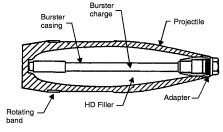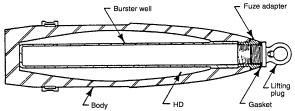Appendix A
Description of Pueblo Chemical Depot Stockpile
The entire inventory of munitions at the PCD contains mustard agent. Most projectiles contain agent HD, which is distilled β,β′-dichloroethyl sulfide. Some contain HT, a 60:40 eutectic mixture of HD and bis[2-(2-chloroethylthio)ethyl] ether. All munitions may contain manufacturing by-products or impurities, degradation products, and inorganic residues
Table A-1 lists the kinds and numbers of munitions in the Pueblo Stockpile.
Figures A-1, A-2, and A-3 are cutaway drawings of the
TABLE A-1 Pueblo Chemical Depot Munitions
|
Item |
Quantity |
Description |
|
105-mm cartridge, M60, HD |
28,375 |
Complete round in field cartridge case with propellant |
|
105-mm rounds, M60, HD |
355,043 |
Bursters only, with dummy plug |
|
155-mm rounds, M104, HD |
33,062 |
Bursters only, with lifting plug |
|
155-mm rounds, M110, HD |
266,492 |
Bursters only, with lifting plug |
|
4.2-inch mortars, HT, M2 |
20,384 |
Fuze, burster, and tail assembly |
|
4.2-inch mortars, HD, M2A1 |
76,722 |
Fuze, burster, and tail assembly |
|
SOURCE: Adapted from U.S. Army 1997. |
||
105-mm shell, 155-mm shell, and 4.2-inch mortar projectile, respectively,
REFERENCES
U.S. Army. 1977. Army Ammunition Data Sheets. TM 43–0001–28, April. Washington, D.C.: Department of the Army.
U.S. Army. 1997. Assessment of Technologies for Assembled Chemical Weapons Demilitarization. Solicitation Number DAAM01–97-R-0031, July28. Aberdeen Proving Ground, Md.: U.S. Army Chemical and Biological Defense Command.

|
M60 Cartridge, 105-mm Howitzer |
|||
|
Length |
31.1 inches |
Booster |
M22 |
|
Diameter |
105mm |
Explosive |
Tetrytol |
|
Total weight |
42.92 lb |
Explosive weight |
0.3 lb |
|
Agent |
HD |
Propellant |
M67 |
|
Agent weight |
2.97 lb |
Propellant weight |
2.83 lb |
|
Fuze |
M557/M51A5 |
Primer |
M28A2/M28B2 |
|
Burster |
M5 |
Packaging |
1 round/fiber container, 2 container/wooden box |
FIGURE A-1 105-mm howitzer projectile. NOTE: M60 105-mm cartridges have been reconfigured and therefore will not have propellant attached. SOURCE: Adapted from U.S. Army, 1977.

|
MHO Projectile, 155-mm Howitzer |
|||
|
Length |
31.1 inches |
Booster |
M22 |
|
Diameter |
155 mm |
Explosive weight |
0.41 lb |
|
Total weight |
94.6 lb |
Propellant |
None |
|
Agent |
HD |
Propellant weight |
None |
|
Agent weight |
11.71b |
Primer |
None |
|
Fuze |
None |
Packaging |
8 rounds/wooden pallet |
|
Burster |
M6 |
|
|
FIGURE A-2 155-mm howitzer projectile. SOURCE: Adapted from U.S. Army, 1977.

|
Cartridge, 4.2-inch Cartridge/Mortar |
||
|
|
M2/HT |
M2A1/HD |
|
Length |
2 1.0 inches |
2 1.0 inches |
|
Diameter |
4.2 inches |
4.2 inches |
|
Total weight |
24.67 lb |
24.67 lb |
|
Agent |
HT |
HD |
|
Agent weight |
5.8 lb |
6.0 lb |
|
Fuze |
M8 |
M8 |
|
Burster |
M14 |
M14 |
|
Explosive |
Tetryl |
Tetryl |
|
Explosive weight |
0.14 lb |
0.14 lb |
|
Propellant |
Evaluation of the Army’s Draft Assessment Criteria to Aid in |
M6 |
|
Propellant weight |
0.6 lb |
0.4 lb |
|
Primer |
M2 |
M2 |
|
Packaging |
1 round/fiber container, 2 containers/wooden box |
1 round/fiber container, 2 containers/wooden box |
FIGURE A-3 4.2-inch mortar cartridge. NOTE: 4.2-inch cartridges/mortars will be reconfigured as projectiles. Most 4.2-inch cartridges will also be defuzed. SOURCE: Adapted from U.S. Army, 1977.





